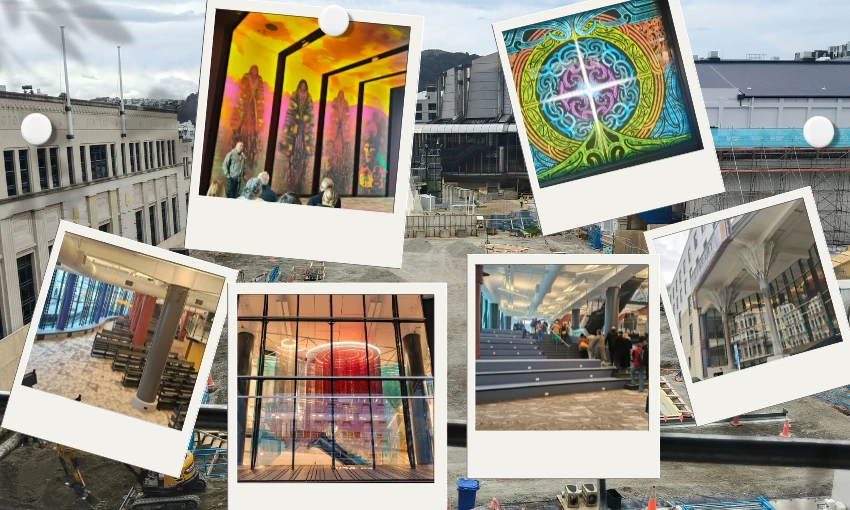By Joel MacManus
Copyright thespinoff

The soon-to-reopen library retains a memory of its past, but has been transformed into something entirely new.
The construction site at Te Matapihi ki te Ao Nui/Wellington Central Library, which has been closed since 2019, conjured a range of emotions for most Wellingtonians. I think the strongest one is loss. A building people loved was stripped to its bones, turned into an ugly mess of concrete and steel, and the loud, horrible buzzing of construction equipment took over what was once a serene urban escape.
To be honest, I donŌĆÖt have particularly strong memories of the old library. It closed just a few months after I moved to Wellington; I went a handful of times, and I loved the vastness of the collections and the cosy reading nooks dotted throughout. But I didnŌĆÖt have any deep nostalgic connection to the building itself; I just miss having a large central library.
Losing the library was an extra blow while the city was down. Wellington is in an economic slump due to several compounding factors: two earthquakes that did significant damage but werenŌĆÖt quite bad enough to warrant central government support, a global pandemic which took a particular toll on city centres, a recession orchestrated by the Reserve Bank, and mass layoffs in the public sector. Amid all this chaos, a major public asset, something we all pay for and benefit from, was rendered completely unusable. A central library adds to the city, as a service centre, a gathering space, a cultural hub, a point of civic pride. Losing the library has made Wellington a worse place to be for the last few years.
What IŌĆÖm saying is that Te Matapihi ki te Ao Nui is more than just a cool building. ItŌĆÖs returning part of the cityŌĆÖs heart to itself. ItŌĆÖs not that this one building will change everything, but itŌĆÖs a reason to hope, a reason to believe that things can get better.
On Saturday morning, I was at Te Matapihi as it was blessed with a tohi t─üngaengae, and the crowd was led on a tour of the site overseen by Rangi Kipa (Te ─Ćti Awa, Taranaki Wh─ünui) from mana whenua design agency Tihei, which partnered with the council and Athfield Architects on the design. This marks the practical completion of the building. In other words, the construction is finished and the building has been handed back over to the council. Now, the work begins to fit it out. Some of the bookshelves are already in, but 400,000 books need to be moved, stacked and categorised, plus all the other furniture, computers and other fun stuff. The fit-out is likely to take several months; the official opening is currently planned for March 2026 to coincide with the completion of works in Te Ng─ükau Civic Square.
It had been almost a year since IŌĆÖd last seen the library. I was invited to view it with council staff when it was very much still a construction site ŌĆō little more than concrete, steel struts and dust. A lot has changed since then.
My first impression was a strange sense of deja vu. Because itŌĆÖs the same building, but it feels so different. Like when youŌĆÖre not sure if youŌĆÖre recalling a real memory or just an eerily prescient dream. ItŌĆÖs still the same shape, sort of a rectangle with a gentle wave rolling along the rear. The central escalators are still in the same place. But beyond that, it feels entirely new.
The biggest change is the sheer amount of natural light. It feels far more open, which also makes it feel bigger. The concrete panelled sides have been replaced with floor-to-ceiling glass. You lose a bit of that cosy, closed-in feel, which I appreciate for a reading space, but it feels brighter and happier.
The entranceways, too, contribute to the building feeling more open. Previously, there was one main entrance on Victoria Street and a smaller exterior connection to Civic Square via a set of tiled stairs or a ramp. Now there are four entrances: the two existing ones (which have been redesigned), plus two new ones on Harris Street and opposite Mercer Street. This was a design priority pushed by mana whenua; more entrances, with more glass, would remove the feeling of a threshold and make it feel like a space that is welcome to all.
ThereŌĆÖs a subtle but important change at the back entrance. Where previously the library was below the ground level of Te Ng─ükau Civic Square, creating a sort of moat that necessitated the stairs and ramp, it now opens directly onto the square; one staff member described the goal as making the library feel like an internal extension of Te Ng─ükau.
As we walked around, library staff explained their plans for the various empty spaces. A new childrenŌĆÖs library in a brighter, friendlier, elevated space on the ground floor. A maker space, with resources for everything from 3D printing to painting, weaving and carving. A permanent youth space that, unlike the previous iterations, wonŌĆÖt be constantly disassembled for author talks and other events. The new home of Capital E, ŌĆ£where the next generation will begin their journey of creativityŌĆØ. A ground-floor cafe, two art galleries, and, on the top level, a dedicated home for Wellington City Archives.
The tour particularly focused on the rawa, a term Rangi Kipa felt was more appropriate than ŌĆ£artworkŌĆØ. On the exterior of the building is the poem Brown Optimism by JC Sturm (Taranaki iwi, Te ─Ćti Awa, Ng─üti Ruanui, Te Pakakohi, and Te Whakat┼Źhea of ┼īp┼Źtiki mai Tawhiti) ŌĆō a powerful, political statement that demands equality for M─üori and addresses the challenges of biculturalism.
Most of the pieces are themed around te taiao, the natural world. Te Tai o te Ao Marama, by Ngahina Hohaia (Taranaki iwi, Te ─Ćti Awa, Ng─üti Ruanui, Ng─üti Moeahu, Ng─üti HaupotoŌĆōParihaka) hangs above the main entrance, an enormous woven piece that depicts a giant mycelial fungus organism that ŌĆ£represents ideas of vibrational energy, the currents of tides, the movement of water and air, and how that manifests itself in the forms of all living thingsŌĆØ. The Harris Street entrance is marked by Ko Rangi, ko Papa by Wiremu Barriball (Te ─Ćti Awa, Ng─üti Raukawa, Te Rarawa), a t─ü moko artist and the lead guitarist for Katchafire. Again, it has a focus on fungi and microorganisms.
The standout for me, both in terms of visual design and space, is Ng─ü Pou Ruahine, also known as The Spirit Room, an area off to the side of the top floor that will be used for civic ceremonies and other official functions. Stretching along the side wall and the ceiling is the strikingly colourful Earth Mothers by Darcy Nicholas (Te ─Ćti Awa, Ng─üi Te Rangi, Taranaki, Ng─üti Ruanui, Ng─üti Hau─ü), which represents ŌĆ£the tapu of the female principle and the many children w─ühine bring into creationŌĆØ.
At the end of the tour, Kipa spoke about trying not just to design a space but to craft an experience so that people would feel something when they come into contact with it. For my part, I felt optimism. ItŌĆÖs been a long time coming, and there is a while to go yet, but this library is something special. ItŌĆÖs something Wellingtonians can look forward to ŌĆō and something they can be proud of.



